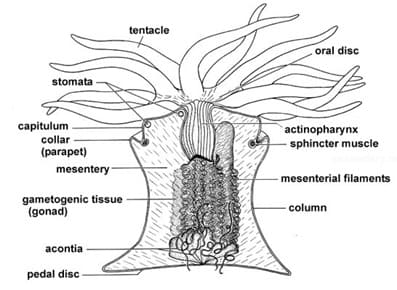Home › Sea Creatures › Marine Biology › Invertebrates › Sea Anemones › Anatomy
Facts about the Body Parts of Sea Anemones
Of all the sessile organisms found in tropical ecosystems, the anemone is a simple polyp that uses its pedal disc to attach itself to a sturdy structure.
The information in this segment explains the physiological and physical characteristics of sea anemone anatomy, such as the digestive system, the structure of the nervous system, and the typical life cycle.
The Anatomical Features of a Sea Anemone
It's easy to characterise most Actiniaria (sea anemones) by the unique structures and unusual colours.
Even so, they also exhibit significant variances in shape, size, and their preferred habits.
For example:
Some species are tiny (1 centimetre), while larger specimens measure almost two metres in diameter. Sea anemone body parts can be thick and stout, or long, cylindrical, and slender.
The mouth (oral disc) is located at the upper section of its body. This is also the location of the anemone's ring of tentacles, some of which may contain stinging cells (cnidocytes) used to stun their prey with venom.
It's worth noting that Amphiprioninae (also known as clownfish) often use the anemone for shelter in a mutualistic relationship and are not affected by the sting.
The polymorphism of these so-called "flowers of the ocean" features a display of subdued colouration with subtle hues of green, brown, purple, blue, and yellow.
Pro Tip: The toxins of some sea anemone species are harmful to humans. Typical examples include the hell's fire anemone (Actinodendron arboreum) and the night anemone (Phyllodiscus semoni).
Sea Anemone Anatomy: Digestion
Because it has an incomplete gut, the sea anemone's gastrovascular cavity functions as its mouth, it digests food, and it also excretes waste matter through the anus.
The slit of the mouth is partially ciliated with hair-like projections as it extends into a flat throat section (pharynx).
In most species, the pharynx is almost half the body length. It extends into a dozen or so "mesentery" chambers around the tubular structure (called the lumen) of the gastrovascular cavity.
 Much like jellyfish anatomy, a thin layer of mesoglea separates the stomach lining which it uses to secrete digestive enzymes.
Much like jellyfish anatomy, a thin layer of mesoglea separates the stomach lining which it uses to secrete digestive enzymes.
Nervous System of Sea Anemone
Despite having a basic nervous system, it's developed enough to process internal physical and chemical conditions (known as homeostasis) via two nerve nets and chemoreceptors.
Here's the thing:
As you may expect from most marine invertebrates, anemones have simple muscles and nerves, albeit more specialised than coral species.
Ocean anemones (order Actiniaria) do not have a rigid skeleton. Instead, they have contractile cells that conduct impulses. This action forms the columnar trunk (a hydrostatic skeleton) by pulling against fluid stored inside the gastrovascular cavity.
Hence, even though the sea anemone is a sessile creature (fixed in one place), it is able to inflate and deflate its body to extend its tentacles when feeding (e.g. aquatic crustaceans) and when it needs to rest.
Sea Anemones Life Cycle
In fact, sea anemones can reproduce sexually, by casting sperm and eggs into the water column, and by asexual reproduction (e.g. the regeneration of new polyps through a process known as pedal laceration).
After fertilisation, the eggs drift with plankton until they have developed into free-swimming larvae. At this point, they will find a suitable place on the seabed to settle and grow into juvenile polyps.
Despite having a conservation status of Least Concern (according to the IUCN Red List), sea anemones are slow to grow and reproduce. An exception to this is the magnificent sea anemone (Heteractis magnifica) which can live for several decades (up to 80 years in captivity).
Related Information and Help Guides
- A to Z List of Marine Invertebrates Examples
- Sea Anemones Fun Facts and Interesting Information
- Sea Sponge Facts and Information with Pictures
- Sea Spider Habitat and Life Cycle with Pictures
- Sea Squirt: Fun Facts about Tunicates
Note: The short video [2:21 seconds] presented by "Deep Marine Scenes" contains more sea anemone facts and explains why Actiniaria is an ideal home for the clownfish.